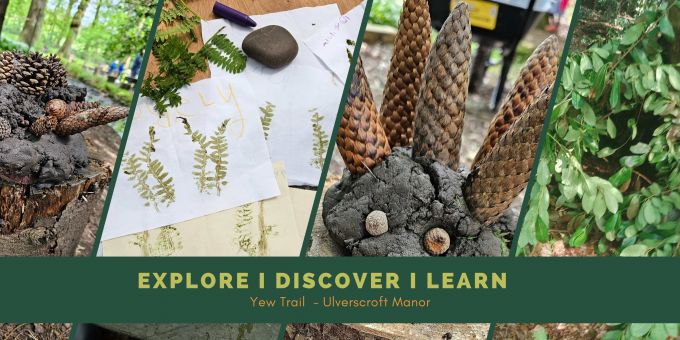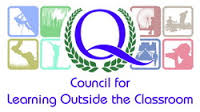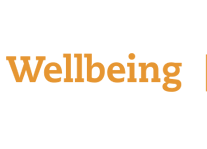Educational Visits

Educational Visits
The Foundation in conjunction with its advisors has completed a full risk assessment and environmental impact study for the Yew Trail and surrounding grounds and operates an on-going safety system for the site. There is onsite parking for coaches and minibuses plus toilet facilities suitable for people with disabilities.
There is a linking path between the Manor and the Grange, the Foundations other property.
If you wish to discuss the site and its facilities, make a visit or booking, please contact the Manor Co-ordinator on:
Phone 01530 245860 (select option 3 for Ulverscroft Manor)
Email: manor@shuttlewood-clarke.org
SCHOOLS
An outdoor classroom has so much to offer. Learning about natural things becomes dynamic because they are all around, to be seen, felt, discovered, explored. The possibility of adventurous activity, valuable in itself, combining with other subject matter can make learning a fun experience. There are endless possibilities for learning across the whole curriculum. The Yew Trail extends to two quite different areas of woodland, one of which is wetland, and has plants which enjoy those conditions. There is a bird hide, yurt, pond, shelter building areas and trails with information boards. There is a range of activity sheets linked to the National Curriculum, plus supporting factual information about, amongst other things, trees, plants, birds. You will find these listed under 'Activity Sheets' and you can access them by obtaining a code from the Foundation's office.
We consider that a visit by group leaders is very important, not just for the purpose of risk assessment, but to evaluate the site as a classroom. A revisit by those who have previously brought groups can be useful, since the site is being continuously improved.
On the day of the visit, Foundation personnel will meet groups on arrival, and will be on site to give whatever assistance is required, including leading activities.
The Foundation has been awarded the Learning Outside the Classroom Quality Mark.
ACTIVITY SHEETS
The Foundation can provide the following Activity Sheets, which you can access after obtaining login details from the office. alternatively the relevant sheets can be e-mailed to you.
|
NOTE: ‘Y’ IN THE REFERENCES BELOW MEANS ‘YEAR’. |
EYFS |
KEY STAGE 1 |
KEY STAGE 2 |
|
Animal Trail - text AT1 |
• | ||
|
Animal Trail species information- text AT1 |
• |
|
|
|
Animal Trail - worksheet AT1 |
• |
|
|
|
Natural Sculpture and Crafts EYFS |
• | ||
|
Shelter Building - text SB EYFS |
• |
|
|
|
Use Your Senses - text version 1 US1 |
• |
|
|
|
Use Your Senses - text version 2 US1 |
• |
|
|
|
Use Your Senses - worksheet US1 |
• |
|
|
|
Yurt - text Y1 |
• |
|
|
|
Bird Hide - text BH1 Y1 |
• | ||
|
Bird Hide - worksheet BH1 Y1 |
|
• |
|
|
Bird Hide - supp worksheet BH1 Y1 |
• | ||
|
Bird Hide - text BH1 Y2 |
|
• |
|
|
Bird Hide - worksheet BH1 Y2 (1) |
|
• |
|
|
Crazy Trail - text CT1 Y1 |
|
• | |
|
Crazy Trail - worksheet CT1 Y1 |
• | ||
|
Crazy Trail - text CT1 Y2 |
|
• |
|
|
Crazy Trail - worksheet CT1 Y2 |
|
• |
|
|
Crazy Trail - completed worksheet CT1 Y2 |
|
• |
|
|
Exploring the woodland - text EW1 Y2 |
• | ||
|
Minibeasts - text M1 Y1 |
|
• |
|
|
Minibeasts - worksheet M1 Y1 |
|
• |
|
|
Minibeast - text M1 Y2 |
• | ||
|
Minibeasts - worksheet M1 Y2 (1) |
|
• |
|
|
Minibeast foodchain worksheet M1 Y2 (2) |
• | ||
|
Minibeast foodchain worksheet M1 Y2 (3) |
• | ||
|
Minibeast Hunt - What they eat M1 & M2 |
• | ||
|
Natural Sculpture and crafts NSC1 |
• | ||
|
Pond Dipping - text PD1 Y1 |
|
• |
|
|
Pond Dipping - worksheet PD1 Y1 |
|
• |
|
|
Pond Dipping - text PD1 Y2 |
|
• | |
|
Pond Dipping - worksheet PD1 Y2 |
• | ||
|
Pond Dipping - How the animals feed PD1,PD2 |
• | ||
|
Pond Dipping - Minibeast Key PD1,PD2 |
• | ||
|
Plant text - P1 Y2 |
• | ||
|
Plants -worksheet P1 Y2 |
• | ||
|
Shelter Building Designs SB1 |
• | ||
|
Shelter Building - text SB1 |
• | ||
|
Trees - text T1 Y1 |
• | ||
|
Trees - worksheet T1 Y1 (1) |
• | ||
|
Trees - worksheet T1 (2-11) |
• | ||
|
Woodland Games -text WG1 Y2 |
• | ||
|
Yurt crafts - text YC1 |
• | ||
|
Animals - Nutrition - text A2 Y3 |
|
|
• |
|
Animals - Nutrition - worksheet A2 Y3 (1) |
|
|
• |
|
Animals - Nutrition - worksheet A2 Y3 (2) |
• | ||
|
Animals - Invertebrates - Nutrition information A2 Y3 |
|
|
• |
|
Bird Hide - text BH2 Y4 |
|
|
• |
|
Bird Hide - worksheet BH2 Y4 (1) |
|
|
• |
|
Bird Hide - worksheet BH2 Y4 (2) |
|
|
• |
|
Bird Hide - worksheet BH2 Y4 (3) |
• | ||
|
Living things Animals - text LTA2 Y6 |
• | ||
|
Living things Animals - worksheet LTA2 Y6 (1) |
• | ||
|
Living things Animals - worksheet LTA2 Y6 (2) |
• | ||
|
Living things Animals - worksheet LTA2 Y6 (3-11) |
• | ||
|
Living things Plants - text LTP2 Y4 |
• | ||
|
Living things Plants - worksheet LTP2 Y4 (1) |
• | ||
|
Living things Plants - worksheet LTP2 Y4 (2) |
• | ||
|
Living things Plants - worksheet LTP2 Y4 (3) |
• | ||
|
Living things Plants - worksheet LTP2 Y4 (4) |
• | ||
|
Living things Plants - text LTP2 Y5 |
• | ||
|
Living things Plants - text LTP2 Y6 |
• | ||
|
Living things Pond Animals - text LTA2 Y6 (12) |
• | ||
|
Living things Pond Animals - worksheet LTA2 Y6 (13) |
• | ||
|
Plants comparison - Example LTP2 Y4 (5) |
• | ||
|
Plants comparison - worksheet LTP2 Y4 (5) |
• | ||
|
Plants tree parts - worksheet P2A Y3 (2) |
• | ||
|
Plants tree parts - supp worksheet P2A Y3 (2) |
• | ||
|
Natural sculptures and craft NSC2 |
• | ||
|
Plants - text P2A Y3 |
• | ||
|
Plants - What Different Plants Need - worksheet P2A Y3 (1) |
• | ||
|
Plants, Flowers and Seeds - text P2B Y3 |
• | ||
|
Plants, Flowers and Seeds - worksheet P2B Y3 (1) |
• | ||
|
Plants seed Dispersal - worksheet P2B Y3 (2) |
• | ||
|
Pond Dipping, how the animals feed PD1, PD2 |
• | ||
|
Pond Dipping water minibeast key PD1, PD2 |
• | ||
|
Pond Dipping - worksheet PD2 Y3 |
• | ||
|
Pond Dipping - text PD2 Y4 (1) |
|
|
• |
|
Pond Dipping - text PD2 Y4 (2) |
• |
||
|
Pond Dipping - worksheet PD2 Y4 (1a, 2a) |
|
|
• |
|
Pond Dipping - worksheet PD2 Y4 (1b) |
|
|
• |
|
Pond Dipping - worksheet PD2 Y4 (1c, 2b) |
|
|
• |
|
Pond Dipping - worksheet PD2 Y4 (2c) |
|
|
• |
|
Shelter Building Designs SB1 |
• |
||
|
Shelter Building - text SB2 |
• |
||
|
Woodland Human Impact - text WHI2 Y4 |
• |
||
|
Woodland Human Impact - worksheet WHI2 Y4 |
• |
TIMETABLES
A timetable is vital to the smooth running of the visit; we normally prepare this following consultation with the group leaders.
PREPARATION OF THE GROUP FOR THE VISIT
- Teachers and leaders are responsible for providing adequate supervision.
- Please ensure that the group has an adequate first aid kit and ideally a qualified first aider. SCF accepts no responsibility for enquiring about health matters, including allergies of visitors.
- If pond dipping is a planned activity, please read the note about Weil's disease on the activity sheet.
- Ensure that all children have suitable footwear; strong shoes in good weather conditions otherwise boots or wellington boots.
- Ensure that clothing is suitable for the weather conditions.
- Consider bringing hand sanitising gel.
- The paths are maintained in a natural state. There are obstacles, and in damp conditions exposed tree roots will be slippery; avoid standing on them.
- Discuss with the children the rules of the visit and involve them in the risk assessment process.
THE VISIT
- Ensure that all adults accompanying the children are fully briefed.
- Ensure that all children follow the paths and stay within the permitted access areas.
- Do not allow children to climb gates or fences.
- Ensure that any cuts and grazes are covered up before you arrive.
- Food and drink can only be consumed in the designated areas.
- Ensure that any litter is placed in the bins provided, or taken away from the site.
- Ensure that all adults and children understand the Yew Trail Code
THE YEW TRAIL CODE
BE SAFE
- TAKE CARE ON UNEVEN GROUND.
- WATCH OUT FOR OBSTACLES.
- DO NOT WANDER OFF ON YOUR OWN.
- SOME PLANTS, FUNGI AND BERRIES ARE POISONOUS: TAKE PROPER CARE .
- ALWAYS WASH YOUR HANDS BEFORE EATING FOOD.
LOOK AFTER THE ENVIRONMENT
- KEEP TO THE MARKED PATHS.
- TAKE YOUR LITTER HOME.
- DO NOT HARM PLANTS, TREES, FUNGI, ANIMALS OR THEIR HABITATS.
- DO NOT START FIRES.










